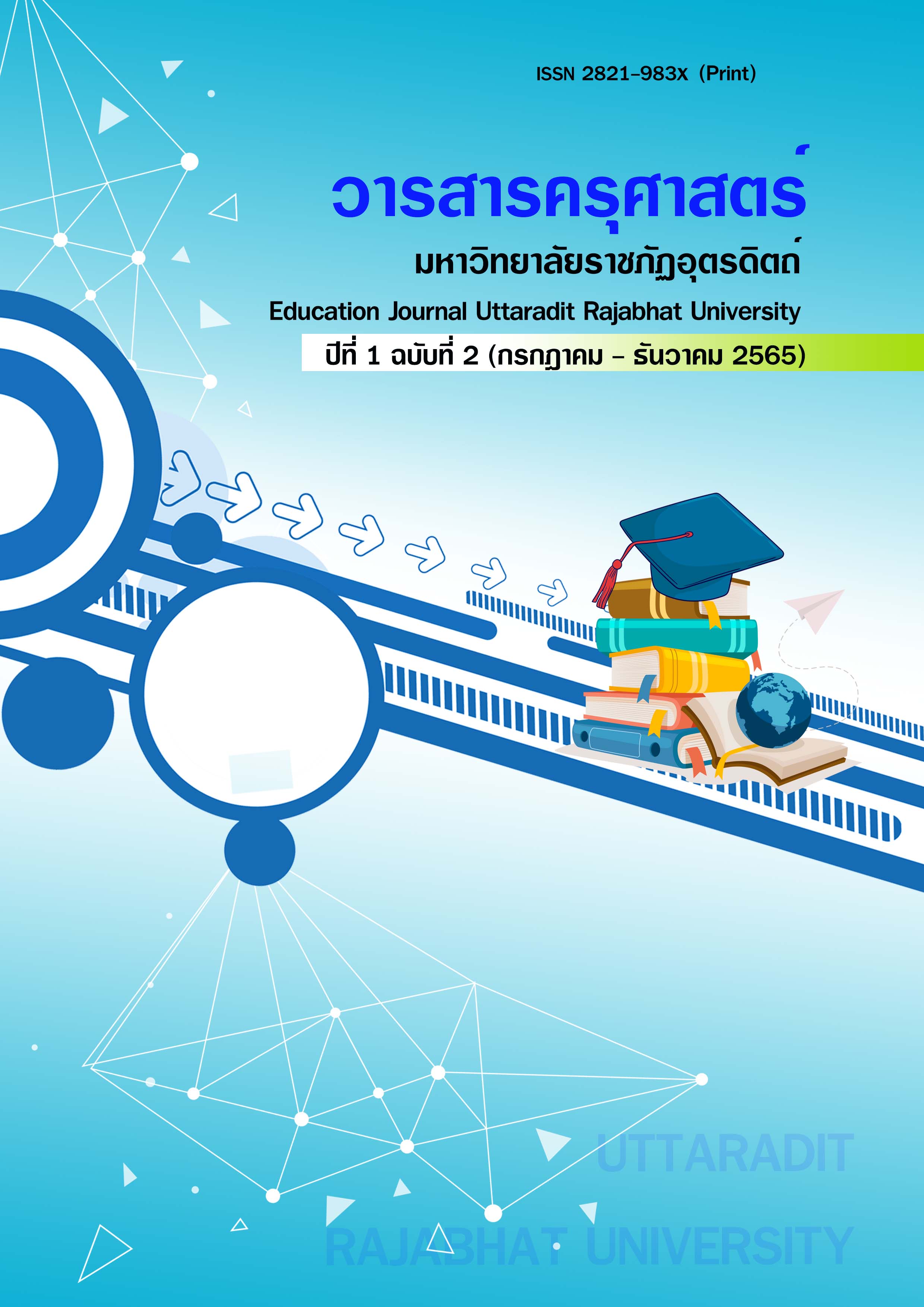Development of a curriculum to enhance English speaking skills for communication Using the B-Slim Model for Mathayom 3 students.
Main Article Content
Abstract
The purpose of this research were to: 1) development of an Enrichment Curriculum English speaking skills for communication by using B-Slim Model for Mathayomsuksa 3 students. 2) to examine the results after implement of development of an Enrichment Curriculum English speaking skills for communication by using B-Slim Model for Mathayomsuksa 3 students. The sample were 20 students of Mathayomsuksa 3 at BanMeatha School by simple random methods. The research instrument consisted of Curriculum and Guide for Enhancing English Speaking Skills for Communication using B-Slim Models and English Speaking Skills Test . The statistics used in data analysis were percentage, mean, standard deviation And t-test
The findings were as follows:
- 1. The result of curriculum development and course quality assessment
1.1 The curriculum that is developed is the curriculum to enhance English speaking skills for communication using B-Slim model for students of Mathayomsuksa 3, consisting of 11 elements, namely 1) Introduction 2) Principles 3) Goals4) Learning Standards Indicators5) Description 6) Learning results 7) Structure and content of the curriculum 8) Learning activities 9) Learning management of the curriculum 10) Instructional Material and learning resources 11) Measurement and evaluation
1.2 The overall quality of the curriculum is at a high level (x̅ = 4.21 S.D = 0.67) and the course manual (x̅ = 4.40 S.D = 0.60)
- 2. The result of using the curriculum to enhance English speaking skills for communication
2.1 The Post-Test mean score of achievement was significant higher than the Pre-test mean score at the statistical at .05 level
Article Details

This work is licensed under a Creative Commons Attribution-NonCommercial-NoDerivatives 4.0 International License.
Faculty of Education Journal Uttaradit Rajabhat University It is a medium for disseminating research results. Academic work Any opinions expressed in the article are solely the personal opinions of the author. Faculty of Education Uttaradit Rajabhat University and the editorial team does not necessarily have opinions that are consistent with those expressed in the article in any way. and is not considered the responsibility of the Faculty of Education Uttaradit Rajabhat University and editorial team
References
กระทรวงศึกษาธิการ. (2551). ตัวชี้วัดและสาระการเรียนรู้ กลุ่มสาระการเรียนรู้ภาษาต่างประเทศในหลักสูตรการศึกษาขั้นพื้นฐาน พุทธศักราช 2551. กรุงเทพฯ: โรงพิมพ์ชุมนุมสหกรณ์การเกษตรแห่งประเทศไทย.
เกศสุดา ปงลังกา. (2550). การศึกษาการใช้กิจกรรมบทบาทสมมติในการพัฒนาความสามารถด้านการพูดภาษาอังกฤษของนักเรียนชั้นมัธยมศึกษาปีที่ 5. (ปริญญานิพนธ์ศิลปศาสตรมหาบัณฑิตการสอนภาษาอังกฤษในฐานะภาษาต่างประเทศ). กรุงเทพฯ: มหาวิทยาลัยศรีนครินทรวิโรฒ.
ณีราวรรณ จิตตรีนิตย์. (2552). ผลการจัดกิจกรรมค่ายภาษาอังกฤษเพื่อพัฒนาทักษะการพูดเพื่อสื่อสาร สำหรับนักเรียนนักเรียนกลุ่มกิจกรรมพิเศษระดับประถมศึกษาตอนปลาย. (ปริญญานิพนธ์สื่อสารสำหรับนักเรียนนักเรียนกลุ่มกิจกรรมพิเศษระดับประถมศึกษาตอนปลาย. ปริญญานิพนธ์ศิลปศาสตรมหาบัณฑิต การสอนภาษาอังกฤษในฐานะภาษาต่างประเทศ). กรุงเทพฯ: มหาวิทยาลัยศรีนครินทร์วิโรฒ.
ทัศนีย์ ธราพร. (2556). การพัฒนาหลักสูตรฝึกอบรมภาษาอังกฤษเพื่อการรุนแรงโดยใช้รูปแบบการสอนแบบเน้นภาระส่งเสริมทักษะการสื่อสาร. (วิทยานิพนธ์ปรัชญาดุษฎีบัณฑิต หลักสูตรและการสอน). นครปฐม: มหาวิทยาลัยศิลปากร.
ธูปทอง กว้างสวัสดิ์ . (2549). การสอนภาษาอังกฤษ. ภาควิชาหลักสูตรและการสอนคณะศึกษาศาสตร์ มหาสารคาม: มหาวิทยาลัยมหาสารคาม.
พิจิตรา ทีสุกะ. (2556). การพัฒนารูปแบบการเรียนการสอน โดยใช้วิจัยเป็นฐานวิชาการพัฒนาหลักสูตรสำหรับนักศึกษาวิชาชีพครู. (วิทยานิพนธ์ปรัชญาดุษฎีบัณฑิต หลักสูตรและการสอน). นครปฐม: มหาวิทยาลัยศิลปากร.
เพชรปาณี อินทรพาณิชย์ และคณะ. (2559 ).การพัฒนาหลักสูตรเสริมเพื่อเสริมสร้างทักษะการคิด วิเคราะห์ สำหรับนักเรียนระดับชั้นประถมศึกษาปีที่ 6 โรงเรียนอนุบาลสกลนคร. วารสารมหาวิทยาลัยนครพนม. 2(2),8-15.
วรรณา ช่องดารากุล . (2558). การประชุมวิชาการนานาชาติด้านการศึกษาพิเศษ ครั้งที่ 1 “นวัตกรรมเสริมสร้างการเรียนรู้และการจัดการเรียนการสอน” กรุงเทพฯ: รุ่งเรืองธรรม.
ราชกิจจานุเบกษา. (2545). พระราชบัญญัติการศึกษาแห่งชาติ (ฉบับที่ 2) พ.ศ.2545. กรุงเทพฯ: โรงพิมพ์องค์การรับส่งสินค้าและพัสดุภัณฑ์.
วัฒนา ตรงเที่ยง. (2553). การพัฒนาหลักสูตรระดับชั้นเรียนเพื่อเสริมสร้างสุขภาพของนักเรียนชั้นประถมศึกษา. วิทยานิพนธ์ปริญญาดุษฎีบัณฑิต (หลักสูตรและการสอน). นครปฐม: มหาวิทยาลัยศิลปากร
ศันสนะ มูลทาดี. (2559). การพัฒนาทักษะการพูดภาษาอังกฤษของนักเรียนชั้นมัธยมศึกษาปีที่ 5 ด้วยวิธีแสดงบทบาทสมมุติ. (วิทยานิพนธ์ศิลปศาสตรมหาบัณฑิต ภาษาศาสตร์ประยุกต์การสอนภาษาอังกฤษ). พิษณุโลก: มหาวิทยาลัยราชภัฏพิบูลสงคราม.
สิริวรรณ คุ้มบ้าน. (2550). การพัฒนาหลักสูตรกลุ่มสาระการเรียนรู้ภาษาไทยเพิ่มเติม ท 40207 วรรณกรรมพื้นบ้านสำหรับนักเรียนชั้นมัธยมศึกษาช่วงชั้นที่ 4 จังหวัดราชบุรี. (วิทยานิพนธ์การศึกษามหาบัณฑิต การสอนภาษาไทย). นครปฐม: มหาวิทยาลัยศิลปากร.
สุกัญญา ศิลปะระสารท. (2544). การพัฒนาความสามารถด้านการพูดภาษาอังกฤษของนักเรียนชั้นมัธยมศึกษาปีที่ 4 โดยใช้กิจกรรมบทบาทสมมติ. (ปริญญานิพนธ์ศิลปศาสตรมหาบัณฑิต การสอนภาษาอังกฤษ). กรุงเทพฯ: มหาวิทยาลัยศรีนครินทรวิโรฒ.
สําลี รักสุทธี. (2544). เทคนิควิธีการจัดการเรียนการสอนและเขียนแผนการสอนโดยยึดผู้เรียนเป็นสําคัญ. กรุงเทพฯ: พัฒนาศึกษา.
สมพร หลิมเจริญ. (2552). การพัฒนาหลักสูตรเสริมเพื่อส่งเสริมความคิดสร้างสรรค์สำหรับนักเรียนช่วงชั้นที่ 2. (ปริญญานิพนธ์การศึกษาดุษฎีบัณฑิต การวิจัยและพัฒนาหลักสูตร). กรุงเทพฯ: มหาวิทยาลัยศรีนครินทร์วิโรฒ.
อริสรา ธนาปกิจ. (2555). อังกฤษพ้นกรอบ. พิมพ์ครั้งที่ 3. กรุงเทพฯ: เวิร์คพอยท์.
อรญา บำรุงกิจ. (2558). กลวิธีการพูดภาษาอังกฤษเพื่อการสื่อสารของนักเรียนระดับมัธยมศึกษา ตอนปลาย: กรณีศึกษา โรงเรียนสาธิตอุดมศึกษา จังหวัดชลบุรี. (วิทยานิพนธ์ศิลปะศาสตร มหาบัณฑิตภาษาอังกฤษเพื่อการสื่อสาร). ชลบุรี: มหาวิทยาลัยบูรพา.
Beauchamp, G.A. (1981). A curriculum Theory. 4th ed. Boston: Peacock.
Bloom, S. (1976). Human Characteristics and School Learning.: McGraw Hill.
Cronbach, L.J. (1963). “ Course Improvement Through Evaluation”. Teachers College Record. 64: 672-683.
Finocchiaro, Mary and C. Brumfit. (1983). The Functional – Notional Approach : From Theory to Practice. London : Oxford University Press.
Harmer, Jeremy. (2001). The Practice of English Language Teaching. 3th ed. London: Longman.
Maslow, A.H. (1970). Motivation and personality. New York: Harper and Row.
Taba, Hilda. (1962). Curriculum Delvelopment, Theory and Practice. New York: Harcourt,Brace.
Trilling, Bernie and Charles Fedel. (2009). 21st Century Skills: Learing for Life in Our Times. New York: John Wiley& Sons.
Tyler, Ralph W. (1950). Basic Principles of Curriculum and Instruction. Chicago: The University of Chicago Press.


